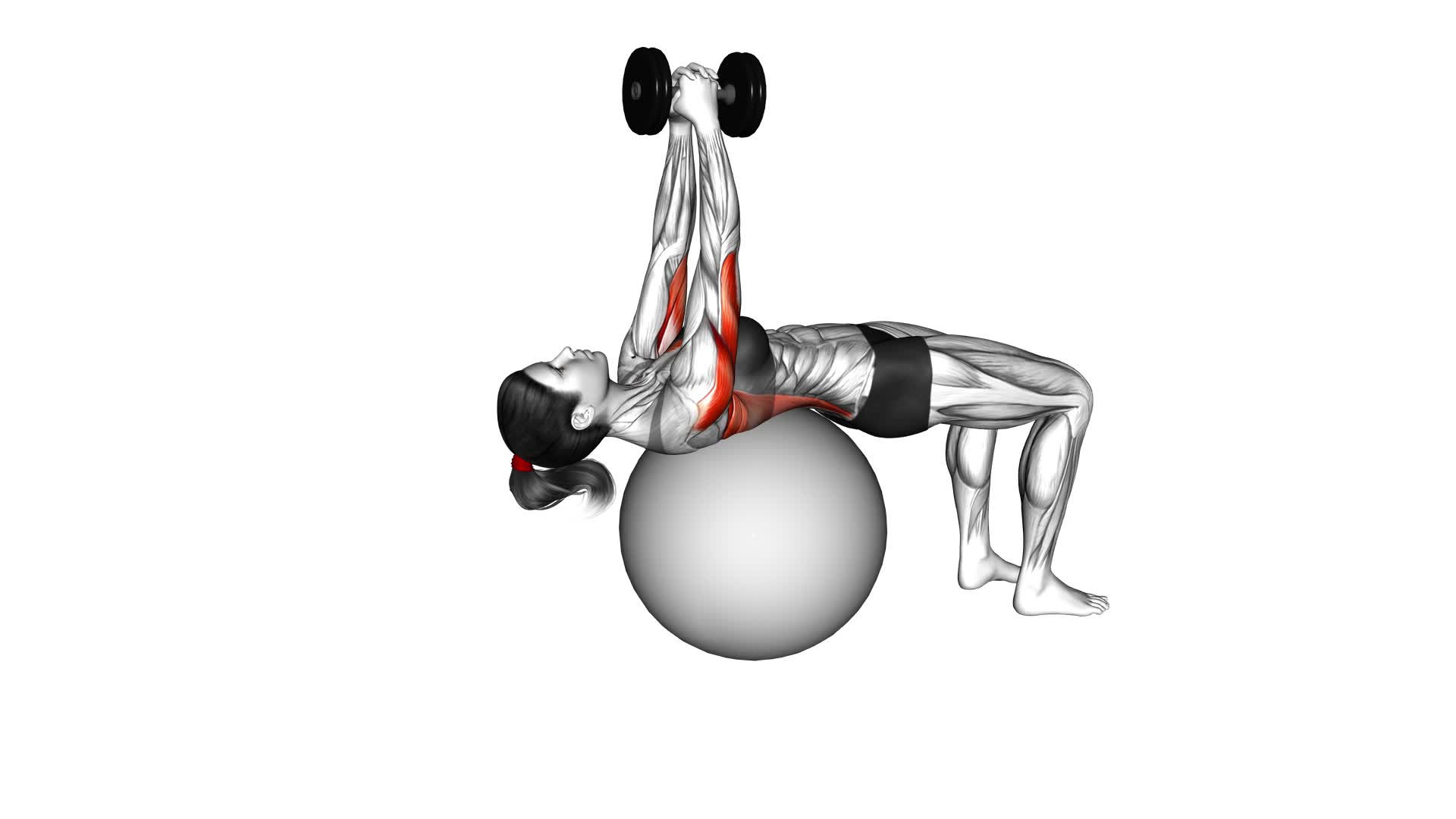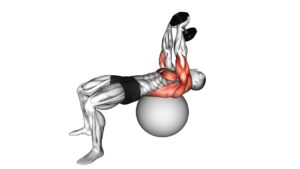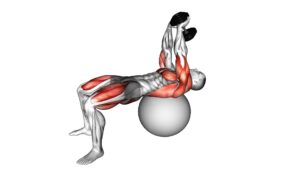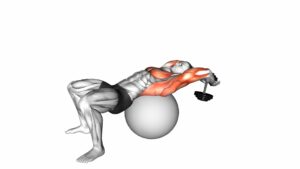Dumbbell Pullover on Exercise Ball (female) – Video Exercise Guide & Tips

Looking to strengthen your upper body and core? The dumbbell pullover on an exercise ball is the perfect exercise for you.
Watch This Exercise Video
In this video exercise guide, we'll show you the proper form and equipment needed to perform this exercise effectively.
Whether you're a beginner or advanced, this exercise has variations to suit your fitness level.
Get ready to maximize your workout with these expert tips for the dumbbell pullover on an exercise ball.
Key Takeaways
- Dumbbell pullover on an exercise ball targets multiple muscle groups including the chest, back, and shoulders.
- Engaging the core muscles for stability and balance is a key aspect of this exercise.
- Proper form and equipment, such as an exercise ball and dumbbell, are necessary for performing this exercise correctly.
- Gradually increasing the weight used for this exercise helps build strength and endurance while avoiding injuries.
Benefits of Dumbbell Pullover on Exercise Ball
You can experience numerous benefits from incorporating the dumbbell pullover on an exercise ball into your workout routine. Not only does this exercise target multiple muscle groups, but it also provides great alternatives to traditional dumbbell pullovers.
The dumbbell pullover on an exercise ball engages your chest, back, and shoulder muscles, helping to improve upper body strength and posture. Additionally, it works your core muscles as you stabilize your body on the exercise ball. This exercise also offers a unique challenge to your stability and balance, as the exercise ball adds an element of instability that requires you to engage your core even more.
By incorporating the dumbbell pullover on an exercise ball, you can effectively work multiple muscle groups while also improving your overall stability and balance.
Now, let's transition into the subsequent section about the proper form for performing the dumbbell pullover on an exercise ball.
Proper Form for Dumbbell Pullover on Exercise Ball
To perform the dumbbell pullover on an exercise ball with proper form, begin by lying on your back with your feet flat on the floor. Hold a dumbbell with both hands and extend your arms straight above your chest. Place the exercise ball under your upper back, making sure it's stable.
One common mistake people make is using a weight that's too heavy. Start with a lighter weight and gradually increase as you become more comfortable with the exercise. Another mistake is arching the lower back excessively. To avoid this, engage your core muscles and maintain a neutral spine throughout the movement.
When performing the dumbbell pullover, it's important to focus on your breathing technique. Inhale deeply as you lower the dumbbell behind your head, and exhale forcefully as you bring it back up to the starting position. This helps stabilize your core and maintain proper form.
Remember to keep your elbows slightly bent and avoid locking them out. This allows for better control and reduces the risk of injury. Keep your movements slow and controlled, avoiding any jerking or swinging motions.
Equipment Needed for Dumbbell Pullover on Exercise Ball
To perform the dumbbell pullover on an exercise ball with proper form, you'll need a few pieces of equipment. Here are the essential items you'll need:
- Exercise Ball: The exercise ball, also known as a stability ball or Swiss ball, is the main piece of equipment for this exercise. It provides an unstable surface, which engages your core muscles and improves balance. Additionally, using an exercise ball can enhance the benefits of the dumbbell pullover by challenging your stability and increasing muscle activation.
- Dumbbell: You'll need a dumbbell to perform the pullover movement. Choose a weight that's appropriate for your fitness level and goals. Start with a lighter weight and gradually increase as you get stronger and more comfortable with the exercise. The dumbbell adds resistance to the movement, helping to target and strengthen the muscles of your upper body, including your chest, back, and shoulders.
- Mat or Towel: It's advisable to have a mat or towel to provide some padding and support for your head and upper back while lying on the exercise ball. This will make the exercise more comfortable and prevent any discomfort or strain on your neck and spine.
Variations of Dumbbell Pullover on Exercise Ball
After familiarizing yourself with the equipment needed for the dumbbell pullover on an exercise ball, it's time to explore the various variations of this exercise.
The dumbbell pullover on an exercise ball is a versatile exercise that can be modified to target different muscle groups and add variety to your workout routine.
One variation is to perform the exercise with a single dumbbell instead of two. This can challenge your core stability and increase the difficulty of the exercise.
Another option is to vary the grip on the dumbbell. By using an overhand grip, you can target your back muscles more effectively, while an underhand grip can engage your chest muscles.
Additionally, you can try performing the exercise on a stability ball instead of an exercise ball. This will require greater balance and stability, leading to a more challenging workout.
Lastly, you can incorporate other dumbbell exercises into the dumbbell pullover on an exercise ball, such as dumbbell flyes or dumbbell presses, to create a more comprehensive upper body workout.
These variations provide alternative workout options and allow you to customize your dumbbell pullover routine to suit your individual needs and preferences.
Tips for Getting the Most Out of Dumbbell Pullover on Exercise Ball
Maximize your results with these tips for getting the most out of the dumbbell pullover on an exercise ball.
- Avoid common mistakes:
- One of the most common mistakes people make when performing the dumbbell pullover on an exercise ball is using too much weight.
- It's important to choose a weight that challenges you but still allows you to maintain proper form.
- Using too heavy of a weight can put unnecessary strain on your shoulders and back, increasing the risk of injury.
- Additionally, make sure to keep your core engaged throughout the exercise to maintain stability and prevent any excessive arching in your lower back.
- Focus on your breathing:
- Proper breathing technique is crucial during the dumbbell pullover on an exercise ball.
- Inhale deeply as you lower the dumbbell behind your head, and exhale as you lift the weight back up.
- This will help you maintain control and stability throughout the movement.
- Gradually increase the weight:
- As you become more comfortable and confident with the exercise, you can gradually increase the weight of the dumbbell.
- Start with a weight that allows you to perform the exercise with proper form and gradually increase the weight as you get stronger.
- This will help you continue to challenge your muscles and make progress over time.
By following these tips, you can ensure that you're getting the most out of your dumbbell pullover on an exercise ball.
Remember to start with a weight that's appropriate for your fitness level, focus on your breathing, and gradually increase the weight as you get stronger.
Frequently Asked Questions
How Many Sets and Reps Should I Do for the Dumbbell Pullover on Exercise Ball?
To get the most out of the dumbbell pullover on an exercise ball, it's important to know how many sets and reps to do.
The number of sets and reps you should perform depends on your fitness goals and current level of strength. Generally, it's recommended to start with 3-4 sets of 8-12 reps.
This will help improve your upper body strength, target your chest, back, and core muscles, and increase overall stability.
Remember to listen to your body and adjust as needed.
Can I Perform the Dumbbell Pullover on Exercise Ball if I Have Lower Back Issues?
If you have lower back issues, it isn't recommended to perform the dumbbell pullover on an exercise ball. This exercise can put strain on your lower back and potentially worsen your condition.
However, there are alternative exercises you can try that target the same muscle groups without putting stress on your lower back. Some options include cable pullovers, chest flies, or bent over rows.
It's best to consult with a fitness professional for personalized advice.
Is the Dumbbell Pullover on Exercise Ball Suitable for Beginners or Only Advanced Fitness Levels?
The dumbbell pullover on an exercise ball can be suitable for both beginners and advanced fitness levels. It offers various benefits, such as targeting the upper body muscles, improving core stability, and enhancing flexibility.
Beginners can start with lighter weights and focus on mastering the proper form before progressing to heavier weights.
Advanced individuals can challenge themselves with heavier weights or incorporate variations, like single-arm pullovers or incorporating a stability challenge by using an unstable exercise ball.
Can I Substitute the Exercise Ball With a Bench or Stability Ball for the Dumbbell Pullover?
Yes, you can substitute the exercise ball with a bench or stability ball for the dumbbell pullover.
Both options can provide stability and support during the exercise.
However, it's important to ensure that the bench or stability ball is sturdy enough to handle the weight and movement.
Make sure to maintain proper form and control throughout the exercise to avoid any injuries.
Consult with a fitness professional for guidance on proper technique and modifications.
Should I Perform the Dumbbell Pullover on Exercise Ball at the Beginning or End of My Workout Routine?
When deciding whether to perform the dumbbell pullover on the exercise ball at the beginning or end of your workout routine, consider the benefits and drawbacks.
Starting with this exercise can activate your core and improve stability for the rest of your workout.
However, if you're already fatigued, it may compromise your form and increase the risk of injury.
Ultimately, it's important to listen to your body and choose a time that aligns with your fitness goals and overall energy levels.
Conclusion
In conclusion, the dumbbell pullover on an exercise ball is a beneficial exercise that targets the muscles of the upper body, including the chest, back, and arms.
By using proper form and engaging the core muscles, this exercise can help improve strength, stability, and posture.
It's important to start with lighter weights and gradually increase resistance as strength improves.
Remember to always consult with a fitness professional before starting any new exercise routine.

Author
Years ago, the spark of my life’s passion ignited in my mind the moment I stepped into the local gym for the first time. The inaugural bead of perspiration, the initial endeavor, the very first surge of endorphins, and a sense of pride that washed over me post-workout marked the beginning of my deep-seated interest in strength sports, fitness, and sports nutrition. This very curiosity blossomed rapidly into a profound fascination, propelling me to earn a Master’s degree in Physical Education from the Academy of Physical Education in Krakow, followed by a Sports Manager diploma from the Jagiellonian University. My journey of growth led me to gain more specialized qualifications, such as being a certified personal trainer with a focus on sports dietetics, a lifeguard, and an instructor for wellness and corrective gymnastics. Theoretical knowledge paired seamlessly with practical experience, reinforcing my belief that the transformation of individuals under my guidance was also a reflection of my personal growth. This belief holds true even today. Each day, I strive to push the boundaries and explore new realms. These realms gently elevate me to greater heights. The unique combination of passion for my field and the continuous quest for growth fuels my drive to break new ground.







